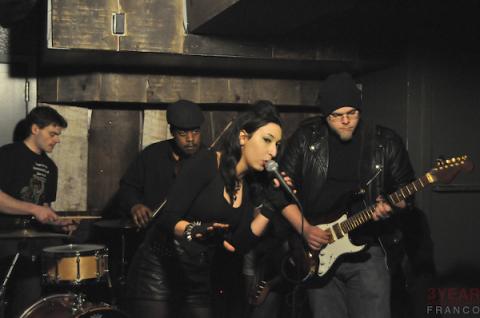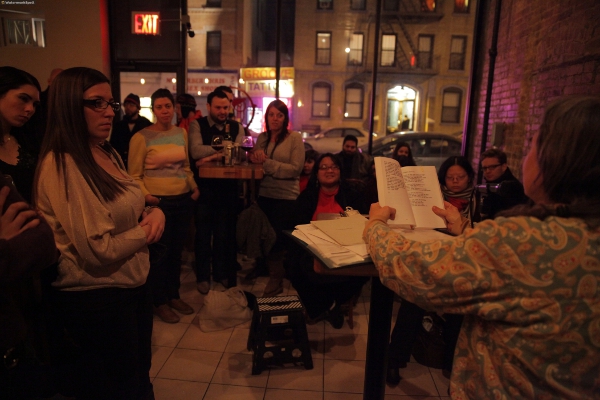New York’s Open Mics Lure Artists From All Walks of Life

People working on a makeshift stage, waiters rushing to deliver drinks to early arrivals, and quirky individuals retiring to the corners appearing to practice some sort of presentation -- we’re at an open mic. The general assumption is that at open mics, drunk temps and shy housewives get on stage to live out some persona they desperately resolved to keep hidden -- choosing stability over a starry-eyed ideal of a life on the stage. This is not really the case. Performances at open mics can be marked by desperation, but in a good way -- by helping to process it. They can also cheer up, make the audience think, and inspire. The intent is to provide a space to express oneself and workshop new ideas in order to gauge the audience’s reaction. Comedians, musicians, poets, and storytellers can use these gatherings to get comfortable appearing in front of crowds and try out new material.
According to Mike Geffner, the organizer of the Inspired Word event series, “We live in an age where the people want to be the story. They want to be the entertainment.” His weekly events are open mic nights that mix storytelling, poetry, music, and comedywith changing hosts. Geffner began holding these events in March 2009 at a small café in Queens, where theywere originally a series of readings, with featured poets, rather than an open mic where anyone could perform. After a while, he relocated to a bigger venue in Manhattan and the event slowly morphed into an open mic -- and a successful one. His is one of the few open mics that can afford to pay the host and the other organizers.
The Inspired Word has featured some pretty famous names, like Jill Eikenberry of Law & Order and L.A. Law and Amber Tamblyn from Joan of Arcadia, and has even been approached by MTV’s Washington Heights and the Travel Channel’s Hidden City for permission to shoot scenes at the event. Despite all of this notoriety, Geffner always tries to keep in touch with those performers who are still trying to make a name for themselves. As he observed, “There were a lot of open mics that I went to that felt very disconnected between the stage and the audience. You were on stage, you were in the audience -- whereas at my events there is more of a familiar, supportive atmosphere.”

After each show, there is usually a trip to a local establishment where anyone is invited to join, mingle, and share their impressions of the evening, which creates a nice sense of camaraderie. Geffner understands this and can relate to the artists, “I remember what it was like to be a young writer, hungry, and wanting to make it happen, and I get to be around those people at least three days a week. That fills me.” He is able to bring this sentiment into the Inspired Word. Actor John Fugelsang, who has been a frequent guest there, summed it up best when he said, “It’s not a show -- it’s a movement.”
After a Tuesday night at the Inspired Word, head over to Lucky Jack's Irish bar on Thursdays, where the Mic Club is housed in the basement, with a stage bar and lounge area. Mic Club, now in its eighth year, has become a well-known spot for artistically-minded people to express themselves in a supportive atmosphere. One of the hosts, Frances, had the idea when she was working in the East Village. “It was a Thursday night, the place was dead and I had this little mini stage and I thought to myself, why the hell have you not got performers coming here and performing and express themselves in the means of art?” She took Sacha Chavez, a musician from Hoboken, as a host and the adventure began. This endeavor resulted in gathering a sizeable community of performers and people interested in the arts who come together and perform.
Each open mic night begins with a ritual of sorts, toasting the free artistic spirits that are fostered there as well as reciting the rules of Mic. Those rules ensure that the artists are respected and helps create a supportive atmosphere free of judgment. Mic Club is an “open mic for the emotionally naked,” according to its website.

In conversation with Sacha, he explained how he identifies strongly with the performers and tries to aid them in their endeavors. Apart from the open mics, Mic Club has featured events where the door money goes to the performer. A little disillusioned, Sacha speaks about the way many performances are booked in New York, “There are these people who call themselves promoters … but basically what they do is they give you a gig and you have to bring like 40 people and you have to give the money to the promoter." His dream is to work with a venue for the good of the performer and offer them a haven where they can focus on their art.
To conclude the week of “open micing,” a visit out to Bay Ridge, Brooklyn is recommended. This open mic here is held at the Owl’s Head, a fairly new establishment in the neighborhood. Recently, the organizers at the Owl’s Head had the idea of doing an open mic in order to suss out members of the literary community. Planned as an experiment, the event was well-received,. Stewart said, “So far we've been getting a healthy mix on stage and in the crowd: old and young, men and women, Bay Ridgites and people from other neighborhoods. [For] the first time we even got a couple of Staten Island readers who brought the house down.”
After hosting the open mics a couple of times, the plan is to “start curating these a bit more, doing nights with local writers we met and liked and with other writers we know from around the borough,” Stewart explains. Further down the road, they are considering hosting a series of readings with the readers from the open mics. Writers being pushed into a working-class neighborhood like Bay Ridge by rising rents have a need for an event to express themselves and thankfully, can come to the Poet’s Society to perform impressive pieces of literature.

Although the three open mics presented are all originals of themselves, there is a common denominator. It is about offering non-professionals a safe and supportive atmosphere onstage to share their artistic endeavors. This adds a valuable element to the cultural life in New York and benefits the performers as well by offering them a chance to hone their skills. Some even say it is an art form itself. Besides, you never know who might come to those performances and see your bit.
Highbrow Magazine
Photos: Jay Franco, Matt Shelly































































































































































































































































































































